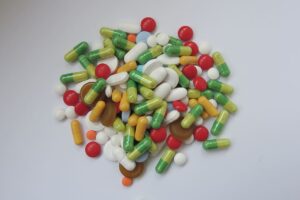Childhood traumatic experiences can have a lasting impact on a child’s mental health and well-being. This can potentially lead to the development of post-traumatic stress disorder (PTSD). Pediatric PTSD is a serious condition that can affect a child’s ability to function in daily life. In this blog, we will discuss some pediatric PTSD treatment options to help children and their families on the path toward recovery.
Contents
What Is Pediatric PTSD?
 Pediatric PTSD (Post-Traumatic Stress Disorder) is a mental health condition that can affect children and adolescents who have experienced or witnessed a traumatic event. Symptoms may include flashbacks, nightmares, avoidance behaviors, hyperarousal, and negative changes in mood and cognition. Common causes of pediatric PTSD include physical or sexual abuse, neglect, accidents, natural disasters, and violence.
Pediatric PTSD (Post-Traumatic Stress Disorder) is a mental health condition that can affect children and adolescents who have experienced or witnessed a traumatic event. Symptoms may include flashbacks, nightmares, avoidance behaviors, hyperarousal, and negative changes in mood and cognition. Common causes of pediatric PTSD include physical or sexual abuse, neglect, accidents, natural disasters, and violence.
Is Pediatric PTSD Treatable?
Yes, it is a treatable condition. Pediatric PTSD treatment options include evidence-based therapies, medication treatments, and self-care practices. Together these treatments can efficiently manage symptoms of PTSD. Children and adolescents need to receive early intervention and treatment to help manage symptoms and improve their quality of life.
Therapy Treatment For Pediatric PTSD
Therapy is the first-line treatment for PTSD in children. Some of the therapies are as:
TF-CBT
Trauma-focused cognitive behavioral therapy (TF-CBT) is an evidence-based therapy that is specifically designed for children and adolescents who have experienced trauma. The therapy is typically provided by a trained mental health professional and involves several components, including psychoeducation, relaxation techniques, trauma narrative, cognitive restructuring, and gradual exposure to traumatic memories. TF-CBT is effective in reducing symptoms of PTSD, depression, and anxiety in children.
Exposure therapy
Exposure therapy involves gradually exposing the child to feared situations or memories in a safe and controlled environment. This helps the child learn that they can tolerate and manage their anxiety and fear. It is based on the idea that exposing a child to triggers in a controlled and safe environment can help him confront his fears. The therapist exposes the child to mild triggers and gradually increases their intensity.
Play therapy
 Play therapy is a form of therapy that utilizes play to help children communicate and process their thoughts and emotions related to the traumatic event. The therapist may use toys, games, and other forms of play to help the child express themselves and work through difficult feelings. Play therapy can help children feel more comfortable in therapy and build a trusting relationship with their therapist.
Play therapy is a form of therapy that utilizes play to help children communicate and process their thoughts and emotions related to the traumatic event. The therapist may use toys, games, and other forms of play to help the child express themselves and work through difficult feelings. Play therapy can help children feel more comfortable in therapy and build a trusting relationship with their therapist.
Pet therapy
Pet therapy involves the use of animals to help reduce stress and anxiety, improve mood and socialization, and increase feelings of comfort and safety. Therapy animals such as dogs, cats, and horses may be used in treatment. These animals can help children feel friendly and happy. They can find a companion in their pet with whom they can play and make memories with.
Family therapy
Family therapy involves the child and their family members. It aims to improve communication, problem-solving, and coping skills. This can help address family issues related to the traumatic event and improve family functioning and support for the child.
IPT
Interpersonal therapy (IPT) is a type of therapy that focuses on improving interpersonal relationships and social support. The therapy may involve discussing the child’s relationships with family and friends. Moreover, this therapy works on communication and problem-solving skills.
MBCT
Mindfulness-based cognitive therapy (MBCT) is a type of therapy that combines mindfulness practices with cognitive therapy techniques. The therapy helps the child develop mindfulness skills to manage difficult emotions and improve mood and well-being. It may include practices like Yoga, Meditation, Deep Breathing, or Exercise. These exercises help in relaxing the body and being present in the moment.
ACT
Acceptance and commitment therapy (ACT) is a type of therapy that focuses on acceptance and mindfulness techniques to help the child learn to accept and cope with difficult thoughts and feelings. The therapy helps the child focus on their values and take action based on those values, even in the presence of difficult emotions or thoughts. This teaches the child to cope up with the trauma without worrying or fearing.
Medication Treatment For Pediatric PTSD
 Medication is not often used as a first-line treatment. However, these are used in moderate to severe cases. Given below are some common medication treatments for pediatric PTSD:
Medication is not often used as a first-line treatment. However, these are used in moderate to severe cases. Given below are some common medication treatments for pediatric PTSD:
- Selective serotonin reuptake inhibitors (SSRIs): SSRIs are a type of antidepressant medication for PTSD in children and adolescents. These medications work by increasing levels of serotonin, a neurotransmitter that helps regulate mood and anxiety.
- Serotonin-norepinephrine reuptake inhibitors (SNRIs): SNRIs are another type of antidepressant medication for PTSD in children and adolescents. These medications work by increasing levels of serotonin and norepinephrine. These two neurotransmitters are involved in mood and anxiety regulation.
- Alpha-agonists: Alpha-agonists such as clonidine and guanfacine treat anxiety and hyperarousal symptoms in children with PTSD. These medications work by regulating the release of adrenaline and noradrenaline. These are the neurotransmitters involved in the “fight or flight” response.
- Atypical antipsychotics: Atypical antipsychotic medications such as risperidone and olanzapine also treat PTSD in children. These work for those who have severe symptoms or are unresponsive to other treatments. These medications can help reduce symptoms of anxiety, agitation, and mood swings.
Self-Care Treatment For Pediatric PTSD
 Self-care practices can be an important part of the overall treatment plan for pediatric PTSD. Here are some self-care strategies that may be helpful for children and adolescents with PTSD:
Self-care practices can be an important part of the overall treatment plan for pediatric PTSD. Here are some self-care strategies that may be helpful for children and adolescents with PTSD:
- Regular exercise: Regular physical activity can help reduce stress and improve mood. Encouraging children to engage in activities they enjoy such as biking, hiking, or dancing can be beneficial.
- Relaxation techniques: Practicing relaxation techniques such as deep breathing, progressive muscle relaxation, or yoga can help reduce anxiety and promote relaxation.
- Healthy sleep habits: Getting enough sleep is important for overall health and well-being. Encouraging children to establish a regular sleep routine and avoid screens before bedtime can help improve sleep quality.
- Balanced diet: Eating a balanced and nutritious diet can help improve mood and energy levels. Encouraging children to eat a variety of fruits, vegetables, whole grains, and lean protein can be helpful.
- Hobbies and interests: Encouraging children to engage in hobbies and interests they enjoy can help reduce stress and promote positive emotions.
- Social support: Having supportive friends and family members can be helpful for children with PTSD. Encouraging children to connect with others who have similar experiences, such as through support groups or online forums, can also be beneficial.
Conclusion
In conclusion, pediatric PTSD is a serious condition that requires effective treatment. Various evidence-based therapies along with medication treatments can be effective in reducing symptoms of PTSD in children and adolescents. Self-care practices, including regular exercise, healthy sleep habits, and mindfulness practices, can also be beneficial as part of the overall treatment plan. If you suspect that your child is experiencing symptoms of PTSD, it is important to seek help from a healthcare professional. Remember, treatment is available, and seeking help is the first step toward recovery.
For more information, please contact MantraCare. PTSD or Post-Traumatic Stress Disorder is a mental health condition that affects people who have experienced or witnessed a traumatic event. If you have any queries regarding Online PTSD Counseling experienced therapists at MantraCare can help: Book a trial PTSD therapy session.


